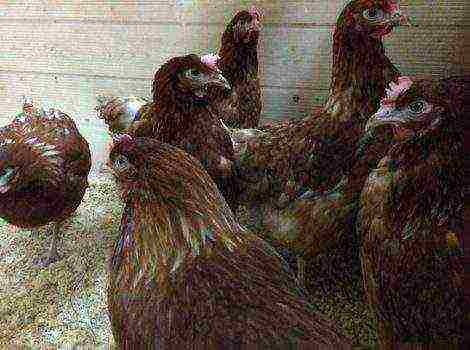Content
Caring for laying hens at home
Chickens are bred for the purpose of obtaining eggs and dietary meat. If you want to have fresh eggs at home all the time, and sell the surplus, then you need to breed egg-type chickens.
Such poultry has a low body weight, thick plumage. They are able to lay eggs after four months of age. Another 20 days after the hen laid the first egg, she is considered a full-fledged productive individual.
In order to have chicken in your household, there are several ways:
- To lay down eggs in the incubator (or put them under a brooding hen) and raise the young;
- Buy chickens and grow it to an adult chicken;
- Buy grown bird and feed her for a couple of months;
- Buy already an adult chicken.
How to choose young animals?
First, the young for the production of eggs are selected from the breeds of the egg direction. It is naive to hope for a high egg production of chickens in another direction, for example, meat.
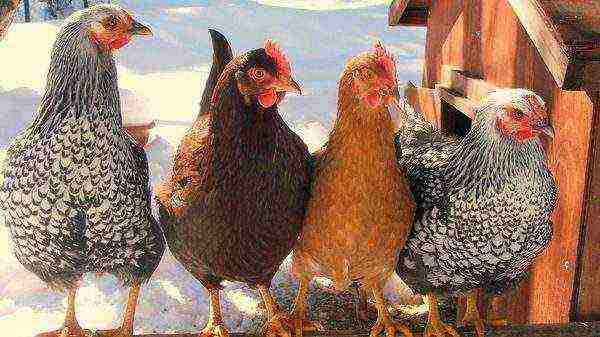
You can choose young from the following breeds: Russian white, Andalusian, Leghorn, Czech golden, May Day, Italian partridge, Minorki, Carpathian greenlegs, Hamburg, Loman Brown, Hisex, Kuchin jubilee others. As a result of selection, new cross-chickens are bred: Borki-1,2, Irtysh, Zaslavsky-1,2,3, Zarya-17, Gibro-6 and many others.
If you have already decided on the breed or cross, when choosing young animals, you need to pay attention to their external signs and habits: the breast is even, the paws are strong, the eyes are bulging, they do not water, the feathers are shiny and clean, the scallop (if it is a grown young) is bright. A young hen should be mobile, without obvious signs of illness, she should not sit on the floor.
Based on these indicators, depending on the age of the young, you can make a good choice for poultry farming.
Home care and maintenance
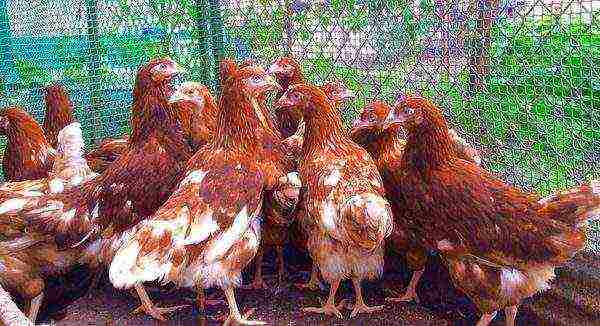
If you have made the right choice of young stock, good care and proper maintenance will ensure excellent results. There are two ways to care for and keep chickens: in cages and in a walk.
Combining these two methods is strongly discouraged as the chicken must get used to certain conditions. Any change in such conditions, the more frequent, leads to stress and a decrease or cessation of egg production.
Breeding hens without range
This method assumes their constant presence in the process of vital activity in special cells.
The size and number of cages directly depends on how many poultry are planned to be kept. 7-8 adult chickens can be accommodated on 1 m2 of area egg direction. If the number of birds is large, the cages are arranged in tiers.
It is not difficult to construct such cells, but this requires a serious investment (in comparison with the second method of maintenance, which will be discussed below).
Making a cage - tips for beginners
We make the cage from a fine-mesh welded mesh. Instead, they also use a chain-link mesh (on the sides and on the back), metal rods in the front. The bottom is two-level.
First, to the frame at a distance of 20 cm.from the bottom point of the structure, we attach a welded mesh at a slight slope so that the eggs can roll into the egg collector, and then we attach a pallet made of plywood, flat slate, or other material, for example, polycarbonate, or other material, to the bottom of the frame.
To increase egg production, it is advisable to carry additional lighting in each cage. And so that she rushes better, you need to either place the cage in the shed closer to the window, or make additional lighting... We choose any type of drinker - vacuum or nipple. In this case, the nipple type is selected.
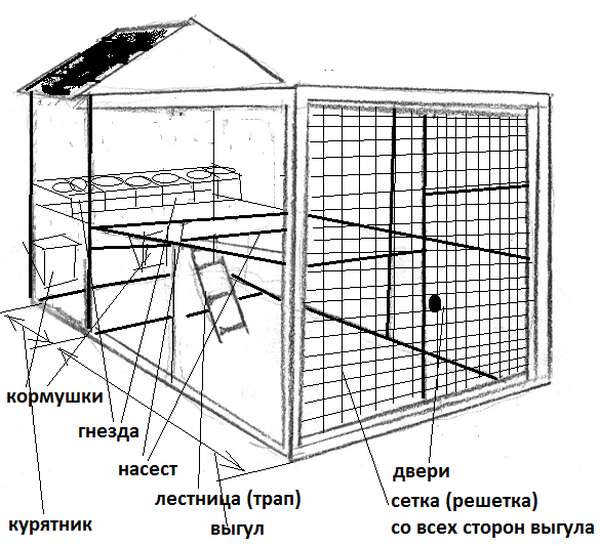
We fix the bottom in the cage at a slight slope to the egg collector so that the eggs can roll into it themselves.
Requirements for the conditions of keeping adult poultry: the cages inside must be clean; the presence of ventilation in the room; optimal containment area (unimpeded food); availability of high-quality fresh feed in feeders and fresh water in drinkers; increased daylight hours; air humidity 69-71%; lack of drafts and dampness; air temperature in summer is 22-25 degrees, in winter - 18-20 degrees.
Feeding: what the diet should contain
When feeding chickens, it is important to take into account that the feed contains the required amount of proteins, fats, carbohydrates, minerals, and vitamins.
- Protein - the main building material for the cells of the body and the main constituent of the egg. They are found in large quantities in legumes, oilcake, bone meal.
- Fats - energy supply of layers. Contained in corn, oats.
- Carbohydrates - the necessary work of all internal organs. It is found in large quantities in juicy feed. There is a lot of fiber in whole unrefined grains.
The most essential vitamins for laying hens are A, B, D.
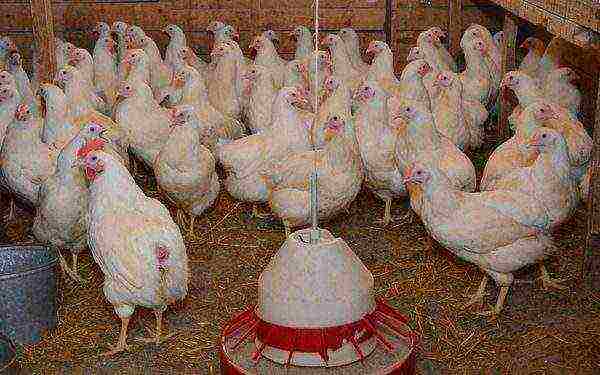
Minerals are essential for the formation of egg shells. There is a lot of it in bone meal, chalk, wood ash.
Feeding for chickens can be provided in two ways:
- buy ready-made feed... Advantages: in such compound feeds, the proportional ratio of nutrients is observed. Disadvantage: their high cost;
- we prepare the mixtures ourselves... Disadvantage: some experience is required + additional time spent for cooking. Benefits: The total cost of the feed is reduced.
With cellular content, it is better to feed 4 times a day, at least 3. We give more grain in the morning and in the evening, in the afternoon - mineral supplements, vitamins, green and juicy food.
Raising chickens with a walk
This type of maintenance is significantly different from the cell, and has almost no differences in feeding. The main difference is the division of the territory into walking areas, where the chickens walk freely, and the chicken coop, where they rush, spend the night (if the chicken coop is built on the street). For laying hens, this option is preferable, since she feels more free.
A hen house with a walk can be made indoors, then the chickens will sleep where it is convenient for them - both in the walk and in the hen house.

Let's consider in more detail the option of a chicken coop with walking on the street.
The size of the aviary depends on the number of livestock. The section for walking can be 2 - 3 times larger in the area of the chicken coop. Such an aviary can be made both collapsible and stationary.... We cover the welded structure made of a shaped pipe or a wooden bar with a netting-netting or a galvanized welded mesh with a cell up to 50 mm.
We do this in the poultry walking section. Pull a protective shading mesh on top. The second part - the chicken coop, we build from plywood or chipboard boards. In the same part we make perches, sections for nests, a ladder or a gangway.
About the chicken coop
In the hen house (meaning that part of the aviary where the chickens are rushing) should be:
- feeder;
- drinker;
- perch;
- ladder (ladder) - if necessary;
- nests.
The number of nests is in direct proportion to the number of layers, i.e. the more there are, the more nests. Put finely chopped straw inside the nests. Extremely it is advisable to install a board with a width in front of the nests 15-20 cm so that the hen can easily get from the roost to the nest.
Feeders - bunkers in the hen house (recall that we are considering an open-air cage option for keeping chickens) is conveniently located outside. Then you just need to open it and fill the food inside. The bird will feed through the feed chute.
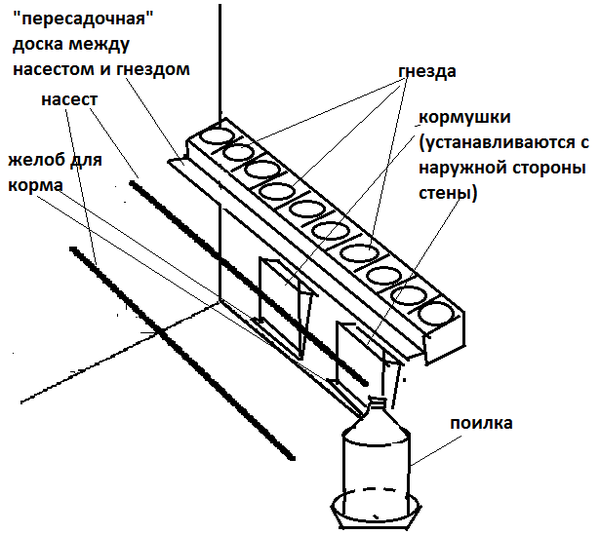
Chicken roost in the household
There are many types of chicken roosts. Their main function is that they serve for the bird to sit on them. From here follow the necessary design features.
The material is usually wood. Firstly, it is available and relatively cheap, and secondly, chicken paws will not freeze on them, which cannot be said about metal poles. You can use ordinary dry strong wood sticks. They should be relatively straight.
It is advisable to choose a bar of such a diameter that it is convenient for the chicken to clasp it with its paws. Neither thick nor thin will do (it will be difficult for her to keep balance).
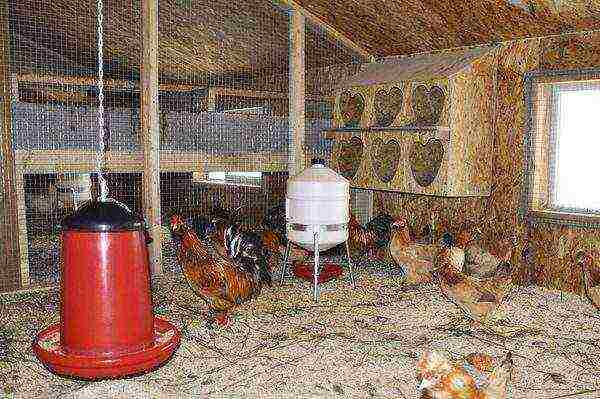
We immediately make a removable perch. This will simplify the cleaning process.... But in this case, you need to fix it very well so that it does not rotate around its axis. We set the roost in 2 or 3 rows, and it is not necessary to do this at the same height. It is desirable to make one perch lower, the other higher, the third at the level of the second or even higher.
They should be positioned relative to each other at such a distance that the droppings of the chicken that sits above do not fall on the bird that sits below. The total length of the perch should be sufficient to accommodate all livestock.
It should be taken into account that in the summer, chickens sit at a distance of several centimeters from each other due to hot weather, while in winter they nestle against each other for additional heating.
You need to install the roost at such a height that the chicken can easily take off on it. A low position does not train their muscles, a high position creates the likelihood that the bird will not climb on it. Ideal - from 50 to 70 cm from the floor.
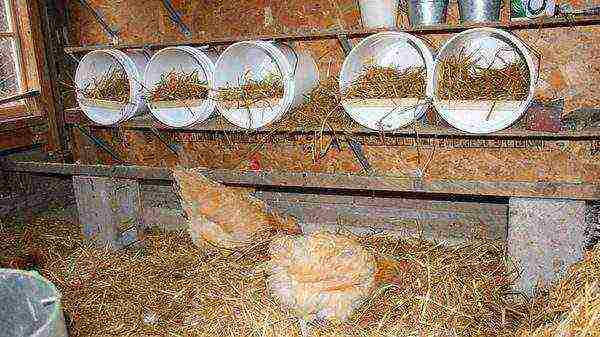
How to care for a bird
The requirements for the conditions of keeping hens in a walking hen house are the same as for keeping them in cages: the cages inside must be clean; optimal containment area (unimpeded food); availability of high-quality fresh feed in feeders and fresh water in drinkers; increased daylight hours; lack of drafts and dampness.
The food is the same as for cage keeping. We add protein feed, mash, etc. in small quantities.
When walking in spring, summer and autumn, there is enough fresh greenery, but if necessary, you can throw juicy grass, watermelon peel, and other food residues. You can limit yourself to two meals of grain - in the morning and in the evening, and once - with a mash, mineral additives, herbs.
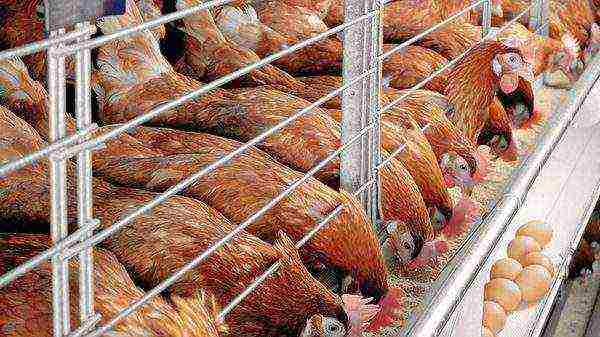
Diseases of chickens and their treatment
Chickens are susceptible to many diseases. To protect them from undesirable consequences, up to death, it is necessary to carry out preventive measures (disinfection of the premises before settling in chickens and after observing safety measures), feed them with high-quality and fresh products, and give vitamins and minerals.
However, it is not always possible to protect the feathered economy.It is worth paying special attention to such common diseases of adult birds as:
- heterocydosis (intestinal worms). It is treated with piperazine. Prevention: thoroughly wash the room;
- salmonellosis (stomach upset). It is treated with tetracycline or dithrevite;
- ascites (fat accumulates in the abdomen). Prevention: it is necessary to give greens;
- arthritis (joint disease). It is treated with ampicillin. Prevention: give only high-quality food, the bedding must be dry;
- Newcastle disease (bird infection through eggshells). Prevention: setting patients off and disinfection of the premises;
- poisoning... Prevention: you need to make sure that the food is fresh and of high quality;
- typhus (stomach is damaged). It is treated with antibiotics such as ampicillin. Prevention: isolation of sick chickens, disinfection of the poultry house;
- streptococcosis (internal organs are affected). It is treated with an antibiotic. Prevention: Isolation of sick chicken;
- tuberculosis (affects chicken lungs). No cure is possible. Prevention: Maintaining hygiene in the house.
Business plan from scratch: costs and profits
The first question that beginners ask themselves before taking on the maintenance of laying hens in order to sell eggs is, is it profitable?
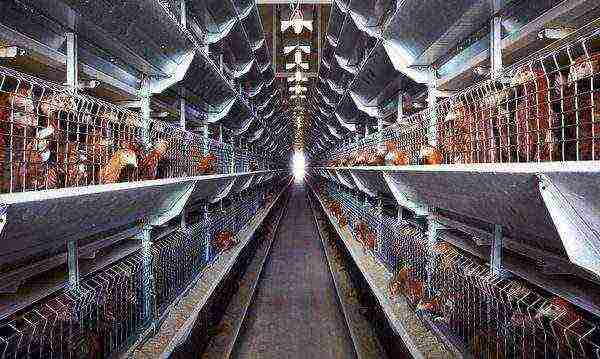
It is possible to draw up in theory 100 business plans, but take into account all the risks and what will be impossible in practice. When calculating a profitable business plan from scratch, it is assumed that chickens will not die or take a small percentage of it when calculating.
In addition, the profitability of production depends on the conditions of maintenance, the number of livestock (the more, the more profitable the production), seasonal weather conditions, chicken breed, feed, and other factors. In the end, it depends on the experience of the breeder himself.
Is it profitable to breed and raise chickens?
We propose to summarize this issue, and show what elements the expenditure part of the budget for growing and profit consists of. Is it profitable or not?
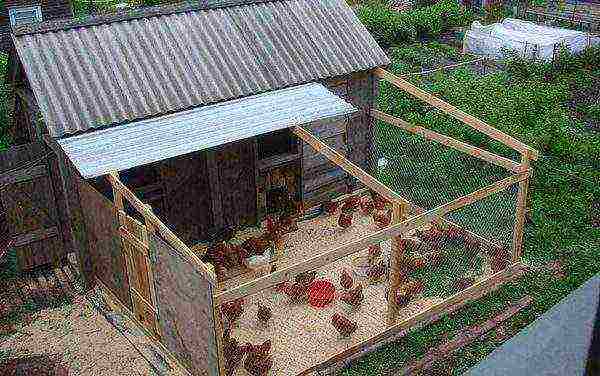
Expenditure part (what you need to spend money on):
- purchase of eggs for the incubator and the cost of electricity (in case we do not start the business with the purchase of young animals or adult chicken);
- purchase chickens or young, or an adult laying hen (in case we do not purchase eggs for the incubator);
- Construction Materials for poultry house equipment (profile pipe, plywood, polycarbonate, flat slate, welded mesh, mesh-netting, other drinkers);
- power consumption for supplementary lighting, heating in winter (increased daylight hours);
- purchase compound feed or grain, vitamins, mineral supplements, medicines;
- Unexpected expenses (and they will definitely be!).
Of the above expense items, most of the money will go to the purchase of chickens or chickens (if you buy them, not raise them) and the purchase of feed.
Income part (for which you can get money):
- from implementation eggs;
- from implementation chicken meat (in the case of the slaughter of an adult hen, the egg production of which has fallen productively to the limits of its cost);
- from implementation droppings.
In the absence of force majeure circumstances, the profitability of breeding chickens leaves from 30 to 100%.
Conclusion
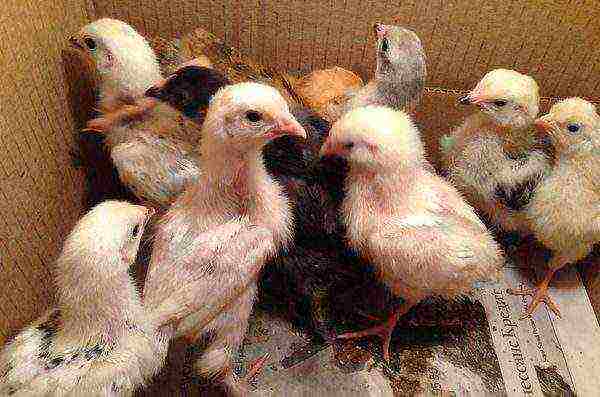
In the final part of the article, we will determine what determines the egg production of chickens. It is influenced by:
- breed of chickens;
- conditions of detention;
- food;
- force majeure in the form of diseases;
- practical experience of the poultry farmer.
Remember! The less stress the laying hen is, the higher the egg production.
